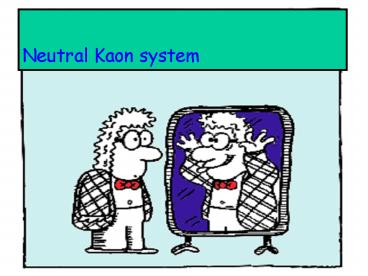Neutral Kaon system - PowerPoint PPT Presentation
1 / 19
Title:
Neutral Kaon system
Description:
Neutral Kaon system. Ko Ko system. Kaon mesons in two isospin ... CKM parameters with CP conserving parameters |Vud| : nuclear Beta decay. 0.9734 0.0008 ... – PowerPoint PPT presentation
Number of Views:34
Avg rating:3.0/5.0
Title: Neutral Kaon system
1
Neutral Kaon system
2
Ko Ko system
- Kaon mesons in two isospin doublets
Part of pseudo-scalar JP0- meson octet with ?,?
K us Ko ds
K- us Ko ds
I31/2 I3-1/2
S1
S-1
- Kaon production
Ko ?- p ??o Ko But from baryon number
conservation Ko ? p ?K Ko p Or Ko ?-
p ??o Ko n n
Requires higher energy
S 0 0 -1 1
S 0 0 1 -1 0
Much higher
S 0 0 1 -1 0 0
3
Kaon oscillations
d
s
W-
u, c, t
u, c, t
_
_
W
-
d
s
K0
K0
u, c, t
_
d
s
W-
W
_
_
_
_
u, c, t
d
s
- So say at t0, pure Ko,
- later a superposition of states
4
Ko Decay
Assume CP
KS
show
mass eigenstates
CP1 CP-1
KL
- In that case
KS branching fractions pp- ? 69, p0p0 ? 31 KL
branching fractions p0p0p0 ? 21, pp-p0 ? 13,
??p?n ? 66
Ks??o?o Ks???- KL???-?o KL??o?o?o
CP1 CP-1
5
Time dependent probabilities for the neutral
kaon case.
t (1/G)
6
Ko Regeneration
- Start with Pure Ko beam
- After time all Ks component decayed
- Introduce slab of material in beam
- reactions
1) Elastic scatttering
2) Charge exchange
3) Hyperon production
- Hence Ko absorbed more strongly
i.e. Ks regenerated
7
Discovery of CP Violation
K1??o?o K1???- K2???-?o K2??o?o?o
So if KL K1 CP eigenstate, Observe no two pion
component
CP1 CP-1
But if broken get
Where ? quantifies degree of CP violation
- BUT Can one find KL decaying into ??-?
8
J.H. Christenson et al., PRL 13,138
(1964) Discovery of CP violation
- Mass and angular spectrum
KL ? pp-X
m (pp-) lt mK
p- pp pp- q angle between pKL and p- If
X 0, p- pKL cos q 1 If X ? 0, p- ? pKL
cos q ? 1
q
m (pp-) mK
KL
m (pp-) gt mK
KL ?
cos q
9
So CP symmetry is violated in the neutral kaon
system.
Mass eigenstates (KS and KL) ? CP eigenstates
Both KS and KL could decay into ?-?-.
- Experimentally well known
- The majority of KS decays into p-p- and KL into
p-p--p0.
In KL
Small but with profound implications
10
CPLEAR revisited
Initial state at t 0
S 0
- Tag Ko/Ko from charged pion/kaon
11
CPLEAR R-(t) and R-(t)
K0
_
_
K0
CP violation
12
CPLEAR CP asymmetry
_
R-(t) - R-(t) R-(t) R-(t)
_
A-(t)
large difference!
- CP violation in mixing
- The two mass eigenstates are not CP eigenstates
13
Kaons CP violation in Decay
CP violation first through existence of certain
decay modes
2.3x10-3
If CP violation is only in mixing, i.e.
independent of decay
So, put channel independent term ? and channel
dependent ?
Hence, by measuring only rates
get
14
So, two expts in the 80s did it
- NA31 (CERN)
- E731 (Fermilab)
- Ambiguous result!
So, two expts did it again.
15
NA48
16
KTeV
17
Measure
Normalisation constants
No normalization is required, but efficiencies,
acceptances etc. have to be corrected
18
Effort over 30 years!
Not easy to compare with SM theory
0.0050 ? 0.0005 ? 0 ? h- ? h00
Note 3 Re h-/h00 - 1, i.e. Re
? 0
19
CKM parameters with CP conserving parameters
- Vud nuclear Beta decay
- 0.9734??0.0008
- Vus semileptonic Kaon and hyperon decay
(CCFR) 0.2196??0.0026 - Vcd Neutrino and anti-neutrino production of
charm off valence d quarks - 0.224 ??0.016
- Vcs W decays (LEP/me!)
- 0.996??0.013
- Vcb semileptonic inclusive and exclusive B
decays (LEP/CLEO) - 0.0412??0.0020
- Vub end point spectrum in semileptonic B
decays(LEP/CLEO) - 0.0036 ?0.0007
- Bo mixing xd, lattice gauge inputs VtbVtd
0.0079 ?0.0015 - Can use Unitarity constraints































